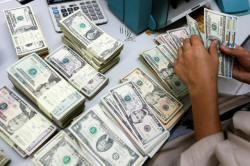|
Dollar steadies, eyes on
U.S. retail sales
 Send a link to a friend
Send a link to a friend
[August 12, 2016]
By Patrick Graham
 LONDON (Reuters) - The dollar held
steady at the end of a week dominated by flows into higher-risk
currency plays like the Australian and Canadian dollars on Friday,
helped by a call for a rise in U.S. interest rates by San Francisco
Federal Reserve chief John Williams. LONDON (Reuters) - The dollar held
steady at the end of a week dominated by flows into higher-risk
currency plays like the Australian and Canadian dollars on Friday,
helped by a call for a rise in U.S. interest rates by San Francisco
Federal Reserve chief John Williams.
The major currencies that carry marginally higher interest rates and
are most closely aligned with commodity markets have all performed
strongly this week as investors sought higher-yielding investments.
The Canadian dollar is up the most since April <CAD=> and Norway's
crown has seen its best performance against the euro since the start
of 2015. <EURNOK=>
Most of those currencies were flat to slightly lower on the day on
Friday, but the Aussie is also up almost 1 percent for the week,
while investors' reaction to a cut in interest rates in New Zealand
was to flood into the kiwi dollar.
"There has been a big-time drift towards the commodity and a number
of emerging market currencies," said Richard Benson, co-head of
portfolio management at London-based currency fund Millennium
Global.

"You just have to look at the price action on the kiwi yesterday to
see that the central banks are now really under pressure but are
also ready to fight this (currency strength)."
Friday's big set-piece is U.S. retail sales data, expected to show a
0.4 percent monthly increase in July, according to the median
estimate in a Reuters poll. <ECONUS>
Benson noted that credit card use data had been poor, suggesting the
risks might be to the downside - threatening both record high U.S.
equity markets and the dollar.
With moves minimal in early European trade on Friday, the Aussie was
down 0.1 percent.
The U.S. dollar, flat on the day, was down 0.3 percent on the week
against the basket of currencies used to measure its broader
strength, while grinding out a small gain against the yen. It was
marginally lower on the day against the euro, against which it has
fallen half a percent this week.
[to top of second column] |

A bank employee counts U.S. dollar notes at a Kasikornbank in
Bangkok, Thailand, May 12, 2016. REUTERS/Athit Perawongmetha

Britain's pound remains under pressure, but has so far proved immune
- or at least steady - in the face of the UK government bond
market's flirtation with negative yields this week.
The pound was roughly unchanged on the day at $1.2960, having dipped
back below $1.30 in expectation of more easing of the Bank of
England's monetary policy in the months ahead. It traded 0.1 percent
lower at 86.04 pence per euro.
"Markets continue to gorge themselves on easy money," said Societe
Generale strategist Kit Juckes.
"In all of this, the FX market is more a sideshow. A little
stability in oil prices has allowed the Canadian dollar to
out-perform the Aussie and the kiwi for a change, and the euro
continues to trend lower against the crown."
[© 2016 Thomson Reuters. All rights
reserved.] Copyright 2016 Reuters. All rights reserved. This material may not be published,
broadcast, rewritten or redistributed.

 |